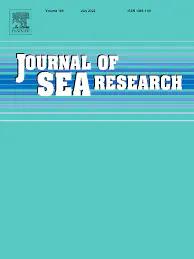Population ecology and habitat preferences of juvenile flounder Platichthys flesus (Actinopterygii: Pleuronectidae) in a temperate estuary

Abstract
The European flounder Platichthys flesus is a widely distributed epibenthic species and an important component of demersal fish assemblages in the European Atlantic coastal waters. In Portuguese estuaries, this species reaches high densities, especially in Minho estuary (NW Iberian Peninsula, Europe), potentially playing an important role in the system’s ecology. In this context, the population structure, production and the habitat use of juvenile P. flesus were investigated. Sampling took place monthly, from February 2009 until July 2010 along the entire estuarine gradient (5 sampling stations distributed in the first 29 km from the river mouth, with S1 located near the river mouth, S2 inside a salt marsh, S3 in a salinity transition zone, while S4 and S5 were located in the upper estuary). Flounder’s density varied significantly among sampling stations and seasons (two-way PERMANOVA: p < 0.001), with the majority of the individuals being found during the spring (30.1%) and in S3 and S4 (72.6%). Males and females presented an even distribution, with a higher proportion of males observed during summer. Fish length also differed among sampling stations and seasons (two-way PERMANOVA: p < 0.001), with larger fishes being found in S1 during the autumn (168.50 ± 59.50 mm) and the smallest in S4 during the spring (33.80 ± 3.12 mm). Size classes associated differently with environmental variables, with larger juveniles being more abundant in the downstream areas of the estuary, whereas smaller juveniles were related to higher water temperatures, suggesting a habitat segregation of P. flesus of different sizes. The fish condition of P. flesus in Minho estuary was higher than in other systems, probably due to the dominance of juveniles on the population. Also, the densities found in this estuary were up to 32 times higher than in other locations, suggesting that Minho estuary is an important nursery area for the species. The estimated secondary production of P. flesus was lower than previous studies acknowledged in the system (0.037 g.WWm− 2.year− 1), indicating that the production estimates of this species in estuaries can vary considerably depending on of several factors such as the sampling year and strategy, population and fish size.